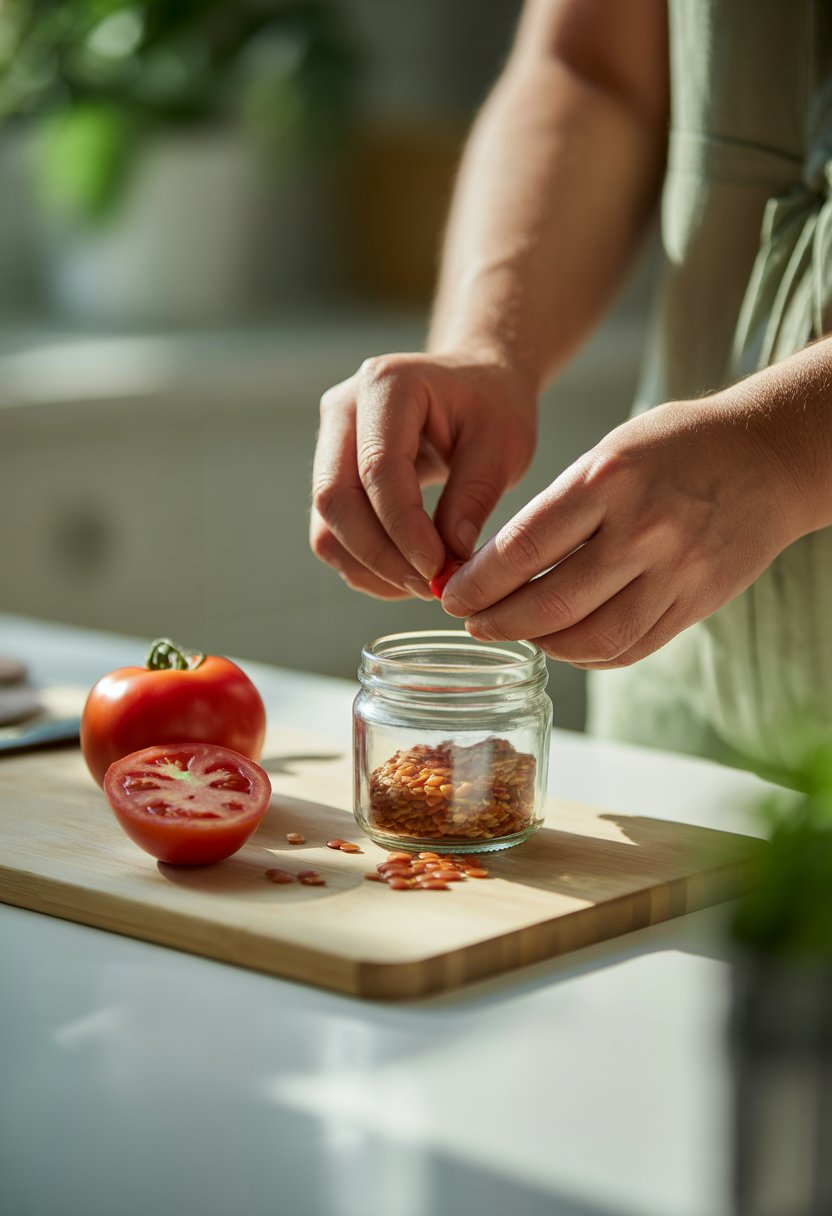Saving tomato seeds allows gardeners to reduce costs while enjoying the rewards of growing their own plants. Learning how to collect and store these seeds can help ensure a steady supply of quality tomatoes year after year.

Taking the time to save seeds also gives gardeners more control over the flavors and types of tomatoes they grow. With a few simple steps, anyone can start making the most of their tomato harvest season after season.
Why It’s Smart to Keep Your Own Seeds

Saving seeds, especially from tomatoes, helps gardeners in a few ways:
- Better Germination: Seeds saved at home often grow better than store-bought ones.
- Adaptation: Tomato seed saving lets seeds get used to the local climate, which can help plants grow stronger.
- Cost Savings: Collecting and storing seeds means less money spent on new seed packets every year.
Keeping your own seeds each season can lead to healthier and more reliable plants over time.
Saving Seeds from Your Own Plants

Not all tomato plants are fit for seed saving. For best results, look for open-pollinated or heirloom tomato varieties. These types will produce seeds that grow into plants like the parent.
Avoid Hybrids:
- Plants labeled
F1orhybridshould not be used. - Hybrid seeds can lead to unexpected shapes, colors, and flavors.
Table: Tomato Seeds You Can Save
| Type of Tomato | Can You Save Seeds? |
|---|---|
| Heirloom | Yes |
| Open-pollinated | Yes |
| Hybrid (F1) | No |
Knowing what you grow helps keep your tomatoes true and reliable.
Will My Tomato Plants Cross With Each Other

Tomatoes are mostly self-pollinating because each flower contains both the male and female parts. This setup usually means each plant fertilizes itself, making cross-pollination rare but not impossible.
Factors that can increase the chance of cross-pollination include:
- Growing different varieties close together
- Strong winds or pollinators like bumblebees moving pollen between flowers
Hybrid varieties are more likely to show surprising traits if cross-pollination happens. Seed savers who want the same type of tomato every year often space different varieties at least 10 feet apart. However, hobby growers sometimes plant tomatoes closer and notice very few, if any, crosses.
| Feature | Details |
|---|---|
| Pollination type | Mostly self-pollinating |
| Cross-pollination | Possible but uncommon |
| Isolation distance | 10 feet recommended |
Steps for Collecting Seeds from Tomatoes

Pick tomatoes that feel soft and are fully ripe for the best chance of gathering viable seed. Slice the tomatoes open and scoop out the seeds and pulp. Separate the seeds from the pulp and let them dry on a paper towel before storing. This helps remove bad seeds and keeps good seeds ready for germination.
Fermenting Tomato Seeds

Fermenting tomato seeds is an important step that helps prepare them for future planting. The process removes a natural gel called locular gel, which keeps the seeds from sprouting inside the fruit. If this gel is not removed, the seeds may have trouble starting to grow or could carry bacteria or diseases.
To start, tomatoes are cut crosswise so the seeds are easy to reach. The seeds are squeezed out and collected in a clean glass jar. Adding a tablespoon or two of water helps create the right environment for fermentation.
Next Steps:
- Cover the jar with plastic wrap to keep out debris.
- Label each jar so different tomato varieties are not confused.
- Place the jar in a warm spot, such as on top of a refrigerator, and let it sit for 3–5 days.
It is important to swirl or gently shake the jar twice a day. In 3–5 days, a thin layer of mold may appear on top. This shows the fermentation process is breaking down the gel and any germination inhibitors. Once fermentation is finished, the mixture should be poured through a strainer, and the seeds rinsed carefully with water.
This method helps get rid of substances that slow down sprouting and may also remove some bacteria that cause plant diseases. Properly fermented and cleaned seeds can be dried and saved for the next growing season.
Steps for Drying Tomato Seeds

After rinsing, tomato seeds should be spread in a thin layer on a mesh screen, such as an old window screen. It’s important to gently separate the seeds so they do not stick together as they dry.
To help seeds dry faster, a fan can be pointed at them.
Let the seeds sit and dry in this way for at least two weeks before moving them to storage.
Tips for Keeping Tomato Seeds Fresh

For best results, place fully dried tomato seeds in a paper envelope or a sealed glass jar. Store the container in a spot that is cool, dry, and dark. Label the seeds with the type and date for easy reference.
Frequently Asked Questions

How should tomato seeds be dried before putting them away?
After cleaning, spread the seeds in a single layer on a plate, coffee filter, or paper towel. Place them in a dry area out of direct sunlight. Stir or move them a little each day to keep them from sticking together. Most seeds dry fully in 7-10 days.
Can seeds be taken from fresh tomatoes and planted later?
Yes, tomato seeds can be saved straight from mature tomatoes. Scoop out the seeds, rinse off the pulp, and dry them well before storing. Plant the dried seeds next season.
What are good steps for saving seeds from heirloom tomatoes?
Pick ripe, healthy heirloom tomatoes. Cut them open and scoop out the seeds with the gel. Soak the seeds in a cup of water for a few days to let them ferment. Rinse and dry the seeds fully, then keep them in a cool, dry place.
Is fermenting tomato seeds needed before saving them?
Fermenting tomato seeds is not required but is helpful. Fermenting removes the gel around the seeds and kills some diseases. It leads to cleaner seeds and often better sprouting.
How can cherry tomato seeds be prepared and kept so they grow well next year?
Take mature cherry tomatoes and get the seeds out. Ferment if possible, rinse with water to remove pulp, and dry them on a plate or paper towel. Store in a paper envelope or an airtight container in a cool, dry spot.
Steps for rinsing and storing tomato seeds for another season
- Put seeds in water and swirl to wash away pulp.
- Drain water through a fine sieve.
- Spread seeds to dry, making sure they don’t clump.
- Once dry, label and store them in a paper envelope or glass jar.
- Keep in a spot that is cool and dry until planting time.

